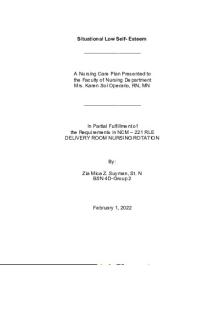Uterine Atony, Nursing care plan PDF

| Title | Uterine Atony, Nursing care plan |
|---|---|
| Author | Trina Martinez |
| Course | nursing |
| Institution | Ateneo de Manila University |
| Pages | 2 |
| File Size | 158.6 KB |
| File Type | |
| Total Downloads | 263 |
| Total Views | 980 |
Summary
o Pathophysiologyo Describe the importance of diagnostic and laboratory test in the given scenario.There are no specific diagnostic or laboratory tests that are mentioned in the case but in reality, diagnostic procedure such as physical examination (abdomen and vagina) is done immediately upon deliv...
Description
o Pathophysiology o Describe the importance of diagnostic and laboratory test in the given scenario. There are no specific diagnostic or laboratory tests that are mentioned in the case but in reality, diagnostic procedure s (abdomen and vagina) is done immediately upon delivery to access the uterine tone. The examination of an individual w that seems enlarged and soft, commonly referred to as “boggy” and will also typically contain a significant amount of b bleeding through the vaginal channel. -A bedside obstetric ultrasound can also be performed to confirm the diagnosis. The ultrasound imaging of the uterus m stripe inside the uterine cavity, which usually corresponds to the remaining parts of the placenta that were not complet -Blood tests such as Hemoglobin or Hematocrit are also done to monitor status and volume of blood loss since a patient post-partum hemorrhage.
o Nursing care plan (Priority and potential Nursing Diagnosis) Priority: Fluid volume deficit related to Active fluid volume loss as evidenced by boggy fundus above the le clots
ASSESSMENT The nurse on duty found the fundus is boggy and above the level of the umbilicus, her BP reveals 90/60 and PR 60 with bounding pulse.
DIAGNOSIS
PLANNING
INTERVENTION
RATIONALE
Fluid volume deficit related to Active fluid volume loss as evidenced by boggy fundus above the level of the umbilicus, and blood clots
Short-Term: After 1-hour of nursing intervention, the patient will be able to;
Independent:
Independent:
Identify risk factors and appropriate interventions . Maintain a bp of at least 100/60mm Hg.
Place the patient in a Trendelenburg position.
Encourag various return facilitate circulation and prev further bleeding.
Compare current fluid intake to fluid goal. Monitor intake and output balance. Assess skin and oral mucus membranes
To ensure accurate picture fluid statu
For signs dehydratio such as skin mucus membrane poor s turgor, delayed capillary refill, or neck vein To incre the clie daily f intake.
Maintain a pr between 7090 bpm
Long-Term: After 2 days of nursing intervention, the patient will be able to;
Maintain fluid volume at a functional level. Demonstrate behaviors or lifestyle changes to prevent development of fluid l
Offer a variety of fluids and water-rich foods, and k h
Collaborative:
Consult dietician as needed.
Collaborative:
To deve dietary p and iden foods to limited omitted.
(pa-check na lang netong ncp sa priority at Risk ate Daneya hehe, baka may mali or kulang) < Potential: Risk for Infection related to decrease in hemoglobin (on the spot kami nag isip ng diagnosis huh ASSESSMENT
DIAGNOSIS PLANNING INTERVENTION RATIONALE Independent: Independent: Risk for Infection Short-Term Assess signs Reflective related to After 1-hour of and inflammato decrease in nursing symptoms of process/ intervention, the hemoglobin infection requiring patient will be able especially evaluation to: temperature. treatment Verbalize understandin g of Note risk To e individual factors for presence/c causative or occurrence r of the infe risk factor(s) of infection. Identify interventions Encourage For mobiliz to prevent or early respiratory reduce risk ambulation, secretions of infection deep prevention breathing, aspiration/ and position ory infectio Long-Term changes After 2-days of Dependent: nursing intervention, the patient will be able to; Demonstrate techniques and lifestyle changes to promote safe environment...
Similar Free PDFs

Uterine Atony, Nursing care plan
- 2 Pages

N101L Care Plan - Nursing Care Plan
- 11 Pages

Nursing-Care-Plan Example
- 12 Pages

Nursing Care Plan. 2
- 2 Pages

Care plan for nursing
- 1 Pages

Nursing Care Plan Activity
- 2 Pages

Nursing Care Plan- mobility
- 2 Pages

65209370 Nursing Care Plan
- 31 Pages

Nursing care plan
- 2 Pages

Nursing Care Plan
- 2 Pages

Nursing Care Plan Dehydration
- 2 Pages

Nursing CARE PLAN Psych
- 2 Pages

Nursing care plan
- 24 Pages
Popular Institutions
- Tinajero National High School - Annex
- Politeknik Caltex Riau
- Yokohama City University
- SGT University
- University of Al-Qadisiyah
- Divine Word College of Vigan
- Techniek College Rotterdam
- Universidade de Santiago
- Universiti Teknologi MARA Cawangan Johor Kampus Pasir Gudang
- Poltekkes Kemenkes Yogyakarta
- Baguio City National High School
- Colegio san marcos
- preparatoria uno
- Centro de Bachillerato Tecnológico Industrial y de Servicios No. 107
- Dalian Maritime University
- Quang Trung Secondary School
- Colegio Tecnológico en Informática
- Corporación Regional de Educación Superior
- Grupo CEDVA
- Dar Al Uloom University
- Centro de Estudios Preuniversitarios de la Universidad Nacional de Ingeniería
- 上智大学
- Aakash International School, Nuna Majara
- San Felipe Neri Catholic School
- Kang Chiao International School - New Taipei City
- Misamis Occidental National High School
- Institución Educativa Escuela Normal Juan Ladrilleros
- Kolehiyo ng Pantukan
- Batanes State College
- Instituto Continental
- Sekolah Menengah Kejuruan Kesehatan Kaltara (Tarakan)
- Colegio de La Inmaculada Concepcion - Cebu


